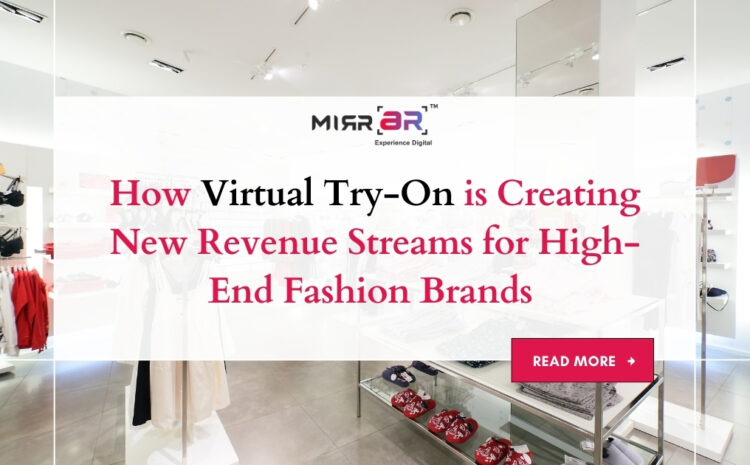The world of luxury fashion has always been synonymous with exclusivity, elegance, and personalized experiences. As the industry evolves to meet the demands of the digital age, high-end brands are turning to cutting-edge technologies to maintain their prestige while reaching broader audiences. One such innovation is Virtual Try-On (VTO), a technology that is transforming how consumers interact with luxury products and unlocking powerful new revenue streams in the process.
Redefining the Customer Experience
Virtual Try-On technology allows customers to visualize how fashion items like clothing, accessories, and jewelry will look on them without the need for physical trials. By integrating augmented reality (AR) and artificial intelligence (AI), platforms like MirrAR are providing hyper-realistic and personalized shopping experiences that resonate with today’s digital-first consumers. High-end fashion is not just about the product—it’s about the experience. VTO elevates that experience by making it more immersive, convenient, and interactive, helping brands forge stronger emotional connections with their customers.
Luxury shoppers expect more than just transactional exchanges; they want storytelling, personalization, and innovation. With VTO, brands can now deliver all three. Imagine a customer virtually trying on a limited-edition diamond necklace through a mobile app or a smart mirror in-store. The immersive trial experience enhances decision-making and builds trust, leading to higher conversion rates.
Expanding Global Reach
Historically, luxury brands have relied heavily on flagship stores in major cities to offer a curated shopping experience. However, this model limits accessibility to a global audience. With the integration of VTO platforms like MirrAR, brands can now offer a premium, boutique-like experience to customers across the globe.
Virtual Try-On breaks geographical barriers, allowing consumers from any part of the world to explore collections, try on products, and make confident purchases. This is especially beneficial for high-end fashion, where hesitation and returns due to uncertainty are common. With accurate, 3D-rendered previews, customers are more likely to proceed with purchases, even for big-ticket items.
Enabling Personalization at Scale
Luxury fashion thrives on bespoke experiences. VTO adds a new dimension to personalization by offering dynamic fitting experiences tailored to individual users. AI-powered sizing recommendations, facial recognition for eyewear, or skin-tone matching for jewelry pieces ensure that every try-on feels curated and unique.
Moreover, data gathered from VTO interactions can help brands gain insights into consumer preferences, popular styles, and buying behavior. These insights empower fashion houses to fine-tune their offerings, stock smarter, and even create customized campaigns that resonate with segmented audiences. This level of personalization, previously limited to in-store VIP services, is now scalable through technology.
Also Read: How Virtual Try-On is Enabling a New Era of Gender-Neutral Fashion Shopping
Reducing Returns and Operational Costs
Returns are a significant concern in e-commerce, especially for luxury brands where every returned item impacts profitability, brand perception, and logistics. Virtual Try-On minimizes this issue by allowing customers to see how a product looks and fits before making a purchase.
Platforms like MirrAR significantly reduce the “trial and error” phase in online shopping. When shoppers can see realistic renderings of products on themselves, they are less likely to return items due to mismatch or dissatisfaction. Fewer returns mean fewer logistical headaches and higher margins for luxury retailers.
Unlocking New Marketing and Engagement Channels
Virtual Try-On is not just a sales tool; it’s also a powerful marketing asset. Social media integration enables users to share their try-on looks online, generating organic buzz and user-generated content for brands. These digital endorsements serve as modern-day word-of-mouth, especially influential among younger demographics who seek validation from their online communities.
Additionally, brands can host live shopping events using tools like MirrAR LIVE, where influencers or stylists showcase collections in real-time while users try them on virtually. This interactive format merges entertainment, personalization, and instant gratification—a trifecta for boosting engagement and revenue.
Driving Sales Through New Platforms
VTO is opening doors to new selling environments, from metaverse stores to mobile apps and smart mirrors in retail outlets. These touchpoints not only extend the brand’s digital footprint but also cater to tech-savvy consumers who expect seamless, multi-channel experiences.
For example, MirrAR’s Metaverse capabilities allow luxury fashion brands to establish virtual boutiques where avatars can try on and purchase digital or physical versions of products. Such innovations attract both traditional consumers and the next generation of shoppers interested in digital fashion, NFTs, and immersive brand interactions.
Conclusion: A Catalyst for Future Growth
Virtual Try-On is proving to be more than a digital gimmick—it’s a strategic tool for growth. For high-end fashion brands, VTO offers a rare opportunity to blend tradition with innovation, maintaining the allure of luxury while adapting to modern consumer behavior.
With platforms like MirrAR leading the way, Virtual Try-On is helping brands create new revenue streams, lower operational costs, and offer unparalleled customer experiences. As fashion continues its digital transformation, VTO will be at the heart of redefining what it means to shop for luxury in the 21st century.
